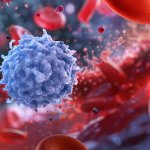Here are some highlights from the year so far:
Stem cells cure one-year-old Harri Stickler
Little Harri Stickler was less than one year old when he was diagnosed with acute lymphoblastic leukaemia. With a survival rate of just 20-30%, his parents were heartbroken, and the chances of success were limited.
Now, one year on, Harri has undergone a miraculous recovery after receiving chemotherapy and a stem cell transplant to rebuild his immune system. His mother says that’s Harri is ‘great’ and doctors have confirmed his treatment was 100% successful.
The little boy has been given a second chance at life – all thanks to stem cell medicine.
A cure for HIV?
Earlier this year, it was revealed that a patient in the UK had entered remission from HIV for more than 18 months. The miraculous recovery came after they received a stem cell transplant and from a donor with a special mutation that causes HIV resistance.
The transplant successfully reconstituted the man’s immune system, and thereby transferred this resistance from donor to patient. Now, although doctors say it is too early to say the patient has been completely ‘cured’, the condition is now ‘undetectable’ in his body in the patient’s body.
It is only the second time that someone has overcome HIV, and suggests stem cells could be key to transforming the lives of 37 million people who have the condition worldwide.
A cure for baldness?
In June, Sanford Burnham Prebys Medical Discovery Institute announced that scientists had created natural-looking hair that grows through skin – all by using human stem cells. Cells are taken from hair follicles and edited to become induced-pluripotent stem cells. Then, scientists use a scaffold to encourage the cells to grow and proliferate.
The breakthrough could be transformative for millions of people, especially considering the fact that 40% of women over 25 suffer from hair loss in the UK, and 33.3% of men over 30.
Stem cell hope for diabetes
Scientists are using stem cells to create insulin-producing cells, it has been reported. Researchers at Washington University School of Medicine in St Louis have coaxed stem cells into becoming insulin-secreting beta cells which they found to be more responsive to fluctuating glucose levels in the blood. Their findings suggest that this approach could be used to help control blood sugar in diabetic people.
Stem cell transplants improve Parkinson’s symptoms
Stem cell transplants significantly improve Parkinson’s treatment Transplanting dopamine-producing stem cells into patients with Parkinson’s disease could improve their motor symptoms, it has been found.
Published in the Journal of Parkinson’s Disease, the research showed that a transplant of stem cells into the brain could provide enough dopamine-producing cells to last a patient’s entire lifespan. As such, they would not need the dopamine medicines which are usually used to treat Parkinson’s disease.
Faster cell recovery after cord blood transplant
A new study published in February suggested that expanded umbilical cord blood produced better results than a standard stem cell transplant.
Researchers found that the expanded cord blood not only had a reduced risk of graft versus host disease (GVHD), but that it also engrafted faster. In fact, 94% (34) patients obtained full engraftment by day 42, compared with an 85% engraftment for the control group.
The time to white cell recovery was also just 11.5 days for patients with the expanded cord blood, whereas it took 21 days for the control group. Likewise, platelet recovery occurred after 34 days compared with 46 days for the control group.
The study has important implications for stem cell transplants – not only could it improve the effectiveness of therapy, but it could also save costs by reducing the need for using two cord blood units for one treatment.
Cells4Life at this year’s World Advanced Therapies & Regenerative Medicine Congress 2019
We attended this year’s World Advanced Therapies & Regenerative Medicine Congress in May, where we heard about the latest developments in stem cell science and cord blood therapies.
Presenters talked about everything from cord blood as a treatment for neurological disorders, to treating diabetes and multiple sclerosis. Read our 5 takeaways from the Congress here.
FIND OUT MORE, REQUEST YOUR WELCOME PACK TODAY
All you need to know to make an informed decision.
Provide your contact details to request:
– Complete Welcome Pack and Parent’s Guide
– Information via email
– Contact from our specialist advisors









